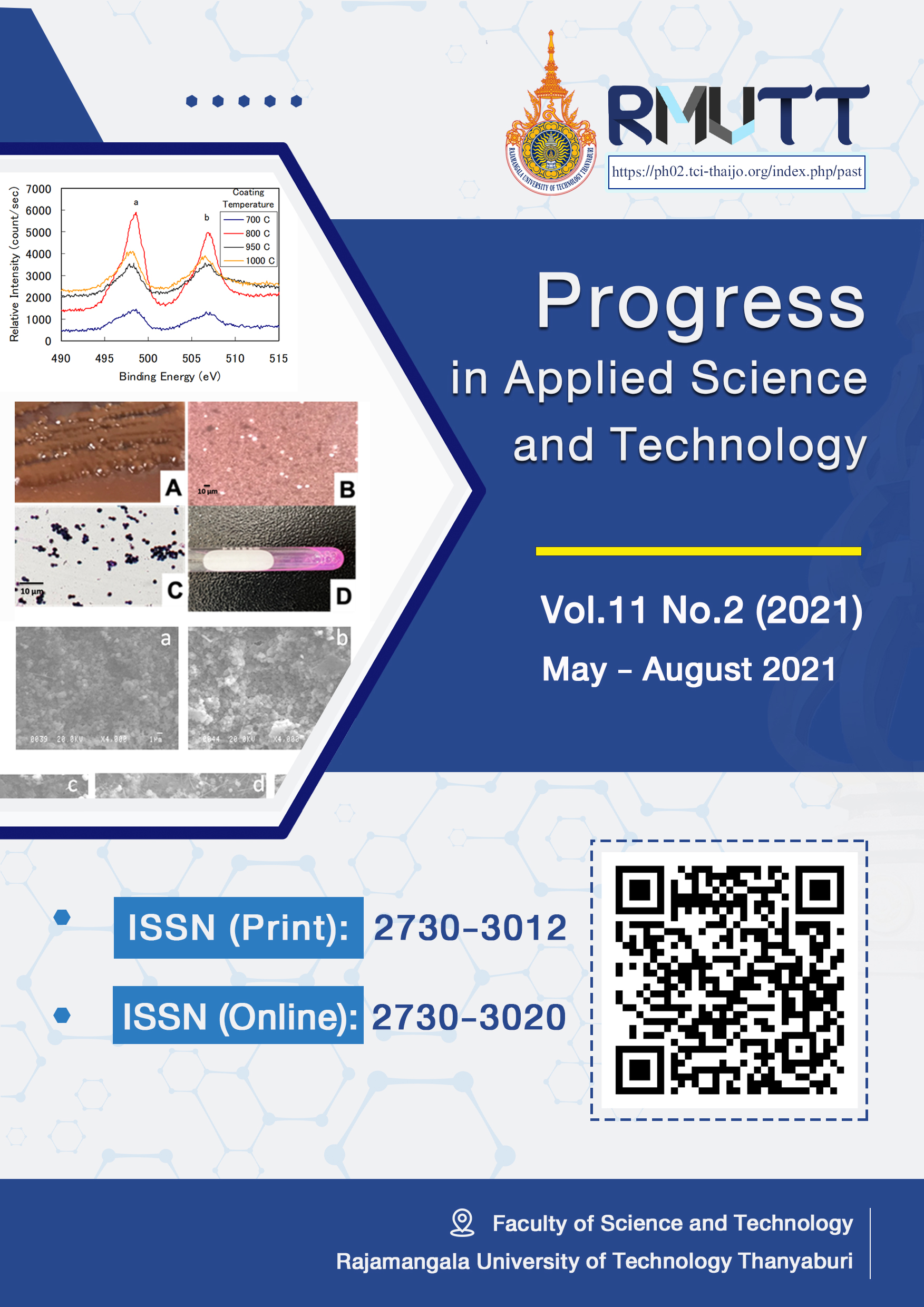Biodegradable Composites Manufactured from Low-Density Polyethylene and Thermoplastic Sago Starch: Preparation and Characterization
Main Article Content
Abstract
Plastic shopping bags, which are usually manufactured from low-density polyethylene (LDPE), are plastic products with significant environmental nuisance factors. A substance that must be in deteriorate, developing for any reason i.e. hydrolysis, Pseudomonas aeruginosa as well as being exposed by natural weather is interesting enough. In this experiment, sago starch (SS) was treated with sodium trimetaphosphate. SS was mixed with LDPE in different ratios of 0, 10, 20, and 30 wt% and was blended with LDPE using the additives (glycerol/urea, 1% benzophenone, and epolene wax) in the same amount of starch. They were compounded via melt mixing technique tracked by injection molded to form sheets. The outcomes showed that the loss of the tensile features of the untreated composite increased steadily with increasing starch content. At 30 wt% of starch loading, the loss of tensile strength (TS) and elongation at break (Eb) was approximately 23.3% and 87.5%, respectively, compared to virgin LDPE. However, for the treatment composite at 30 wt% starch loading compared to virgin LDPE, the loss of TS and Eb was about 17.3% and 98.8%, respectively. The reduced tensile strength percentage of the treated composite indicates that the good distribution and uniformity of SS in the LDPE was low but more elongated at break than in the untreated composite. The biodegradability of this composite was tested by determining a decrease in weight, morphology, and tensile features during exposure to hydrolysis, Pseudomonas aeruginosa as well as natural weather.
Article Details

This work is licensed under a Creative Commons Attribution-NonCommercial-NoDerivatives 4.0 International License.
References
Azahari N., Othman N., Ismail H. Biodegradation studies of polyvinyl alcohol/corn starch blend films in solid and solution media. Journal of Physical Science. 2011; 22: 15-31.
Bastioli C. Global status of the production of biobased packaging materials. Starch‐Stärke. 2001; 53: 351-55.
Rujnić-Sokele M., Pilipović A. Challenges and opportunities of biodegradable plastics: A mini review. Waste Management & Research. 2017; 35: 132-40.
Ju J., Xie Y., Guo Y., Cheng Y., Qian H., Yao W. Application of starch microcapsules containing essential oil in food preservation. Critical reviews in food science and nutrition. 2020; 60: 2825-36.
Qiao D., Li S., Yu L., Zhang B., Simon G., Jiang F. Effect of alkanol surface grafting on the hydrophobicity of starch-based films. International journal of biological macromolecules. 2018; 112: 761-66.
Beg M.D.H., Kormin S., Bijarimi M., Zaman H.U. Environmentally degradable sago starch filled low-density polyethylene. Journal of Polymer Engineering. 2015; 35: 551-63.
Ghatge S., Yang Y., Ahn J.-H., Hur H.-G. Biodegradation of polyethylene: a brief review. Applied Biological Chemistry. 2020; 63: 1-14.
Peres A.M., Oréfice R.L. Effect of incorporation of Halloysite nanotubes on the structure and properties of low-density polyethylene/thermoplastic starch blend. Journal of Polymer Research. 2020; 27: 1-10.
Goheen S., Wool R. Degradation of polyethylene–starch blends in soil. Journal of applied polymer science. 1991; 42: 2691-701.
Shin M., Song J., Seib P.A. In vitro Digestibility of Cross‐Linked Starches–RS4. Starch‐Stärke. 2004; 56: 478-83.
Lee W.-J., Youn Y.-N., Yun Y.-H., Yoon S.-D. Physical properties of chemically modified starch (RS4)/PVA blend films—part 1. Journal of Polymers and the Environment. 2007; 15: 35-42.
American Society for Testing and Materials. D638−14 Standard Test Method for Tensile Properties of Plastics. Standard Test Method for Tensile Properties of Plastics. 2014; 17.
Arvanitoyannis I., Biliaderis C.G., Ogawa H., Kawasaki N. Biodegradable films made from low-density polyethylene (LDPE), rice starch and potato starch for food packaging applications: Part 1. Carbohydrate Polymers. 1998; 36: 89-104.
Kiatkamjornwong S., Pabunruang T., Wongvisetsirikul N., Prasassarakich P. Degradation of cassava starch-polyethylene blends. J Sci Soc, Thailand. 1997; 23: 135-58.
Obasi H. Studies on biodegradability and mechanical properties of high density polyethylene/corncob flour based composites. International Journal of Scientific and Engineering Research. 2012; 3: 259-72.
Febrianto F., Setyawati D., Karina M., Bakar E.S., Hadi Y.S. Influence of wood flour and modifier contents on the physical and mechanical properties of wood flour-recycle polypropylene composites. J Biol Sci. 2006; 6: 337-43.
Wang Y.J., Liu W., Sun Z. Effects of glycerol and PE‐g‐MA on morphology, thermal and tensile properties of LDPE and rice starch blends. Journal of Applied Polymer Science. 2004; 92: 344-50.
Gattin R., Copinet A., Bertrand C., Couturier Y. Biodegradation study of a coextruded starch and poly (lactic acid) material in various media. Journal of applied polymer science. 2003; 88: 825-31.
Agamuthu P., Faizura P.N. Biodegradability of degradable plastic waste. Waste management & research. 2005; 23: 95-100.
Miltz J., Narkis M. The effect of ultraviolet radiation on chemically crosslinked low‐density polyethylene. Journal of Applied Polymer Science. 1976; 20: 1627-33.
Danjaji I., Nawang R., Ishiaku U., Ismail H., Ishak Z.M. Degradation studies and moisture uptake of sago-starch-filled linear low-density polyethylene composites. Polymer Testing. 2002; 21: 75-81.






